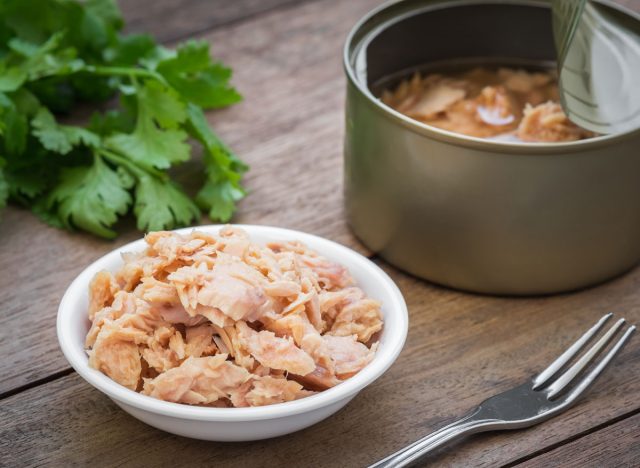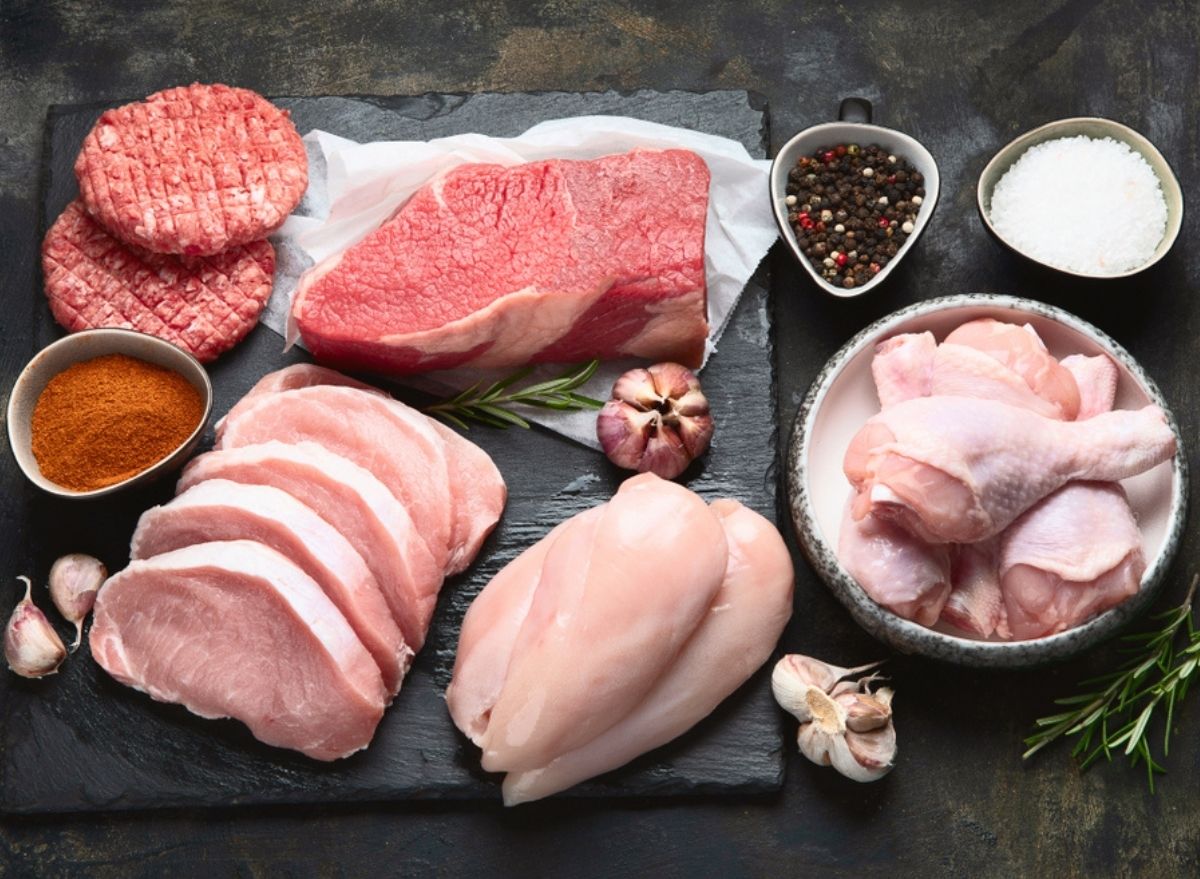Meat is considered a good source of protein for several reasons. For one, it contains all of the essential amino acids, making it a complete protein source. It also contains bioavailable nutrients that you can’t find in plant foods, and it helps with growth, recovery, and workout repair. And even though all meat contains protein, there are some high-protein meats that would be better to add to your diet than other types if you’re looking to pack in this nutrient.
While meat can be a good source of protein, it’s worth noting that there are other sources of protein available as well, including plant-based options like legumes, tofu, tempeh, and certain grains. A varied and balanced diet can provide sufficient protein from a combination of animal and plant sources, accommodating different dietary preferences and needs. However, if you’re able to eat meat and enjoy it, there are benefits you’ll get from high-protein meat that you wouldn’t necessarily get from most plant-based sources.
Benefits of high-protein meat
- Complete protein: Meat contains all the essential amino acids required by the human body for optimal function. Essential amino acids cannot be produced by our body and you must obtain them from your diet. Complete proteins make an excellent source of high-quality protein.
- Rich in bioavailable, essential nutrients: Meat is not only a source of protein but also provides various essential nutrients that are important for overall health. It contains essential vitamins such as Vitamin B12, iron, and zinc. The protein in meat is highly bioavailable, which means it is easily absorbed and utilized by the body. The amino acids present in meat are readily digestible and have a high absorption rate compared to plant-based protein sources. This makes meat an efficient and effective source of protein for meeting your body’s needs.
- Muscle growth and repair: Protein is essential for muscle growth, repair, and maintenance. Meat, being a protein-dense food, provides the necessary amino acids required for these processes. It is particularly rich in high-quality, complete protein, making it an ideal choice for individuals looking to build and maintain muscle mass.
Guidelines for eating meat in a healthy way
The amount of meat that is considered healthy depends on several factors: your individual dietary needs, your health status, and personal preferences. The American Heart Association suggests limiting the consumption of lean meats, poultry, and seafood to 5.5 ounces per day for an average 2,000-calorie diet. Here are some other things to consider when deciding what type of meat to eat and how much.
- Consider your portion sizes: A standard serving of meat is typically around 4 ounces, which is about the size of a deck of cards or the palm of your hand.
- Variety and moderation: Instead of relying solely on red meat as the primary source of protein, consider the many other options like beans, tofu, dairy, eggs, fish, and poultry. Choosing a variety of protein sources increases the variety of nutrients you get as well.
- Balance your plate: Choose a balance of different food groups, including fruits, vegetables, whole grains, and healthy fats, in addition to your meat selection.
- Individual needs: It’s important to consider individual factors such as your age, gender, activity level, and any specific dietary requirements or restrictions you may have.
Ultimately, the key is to approach meat consumption in moderation, emphasizing lean cuts, and balancing it with a variety of other nutritious foods to achieve a well-rounded and healthy diet. Let’s find out exactly which varieties of high-protein meat expert dietitians recommend.
The best high-protein meats


Protein per 3 ounces: 22 grams
“Bison is one of my favorite protein-rich meats to recommend! Because bison is lower in fat than beef, but has a delicious gamey flavor, bison burgers are really great options for those struggling with reflux who usually have a difficult time tolerating your average beef burger without compromising on taste. Bison is also a great source of iron, zinc, and B vitamins, and is particularly high in selenium—a nutrient that’s important for supporting thyroid health,” shares McKenzie Caldwell MPH, RDN, a fertility and prenatal dietitian.


Protein per 3 ounces: 27 grams
Canned tuna is a superb protein source, making it a go-to option for individuals seeking a convenient and nutritious addition to their diet. With approximately 27 grams of protein per 3-ounce serving, canned tuna delivers a substantial protein punch. It boasts a complete amino acid profile, essential for tissue repair and overall health.
Moreover, canned tuna contains heart-healthy omega-3 fatty acids, which are important for your cardiovascular well-being. Its versatility, affordability, and long shelf life make it an ideal choice for quick, protein-packed meals. When it comes to a reliable and nutrient-dense protein source, canned tuna reigns supreme.


Protein per 3 ounces: 26 grams
Jessie Carpenter, MA, MS, RD weighs in: “Elk is often an overlooked meat source but it is tasty, lean, and full of nutrients. It contains the lowest amount of cholesterol and highest amount of zinc compared to beef, turkey, and even bison. My husband and I hunted elk last year in Wyoming and love sharing the meat with others to experience, whether as steaks, jerky, or ground for spaghetti.”


Protein per 3 ounces: 24 grams
“One of the best high-protein meats is chicken breast. Chicken breast is not only a lean source of protein, but it is also low in fat and calories. Regular consumption of chicken breast can contribute to muscle growth, repair, and maintenance. Additionally, it contains essential nutrients like vitamins B6 and B12, which support energy metabolism and brain function. It is one of the most versatile and accessible meat proteins. Grilled, slow-cooked, or roasted, chicken breast is a meat that is nutritiously high in protein,” says Wan Na Chun, MPH, RD, CPT.


Protein per 3 ounces: 20 grams
Salmon earns its reputation as a nutritional powerhouse with approximately 20 grams of protein per 3-ounce serving. What sets it apart is the presence of high-quality, complete protein, containing all the essential amino acids your bodies need and a healthy dose of heart-healthy omega-3 fatty acids, known for their anti-inflammatory properties and potential benefits for brain health.
Additionally, salmon is a rich source of important nutrients like vitamin D, vitamin B12, selenium, and potassium, contributing to your overall well-being. Whether grilled, baked, or added to salads and sushi rolls, salmon’s delicious taste and nutritional profile make it an excellent choice for those seeking a flavorful protein source that nourishes the body.


Protein per 3 ounces: 23 grams
“Besides being Thanksgiving’s meat of choice, turkey is a protein powerhouse. Turkey is rich in B-vitamins B6, B12, choline, and niacin, and is naturally low in fat. I love making turkey burgers in the summer and adding ground turkey to chili for a comforting meal on cold nights,” advises Catherine Karnatz, MPH, RD, registered dietitian and creator of Nutrition Education RD.


Protein per 3 ounces: 25 grams
READ RELATED: A Twist In The Tail With Doga: Amazing Benefits of Doing Yoga With Your Dog
Grandma’s wisdom shines through with her recommendation of liver and onions. Beef liver is an impressive source of essential nutrients, including vitamin A, vitamin B12, and protein. To prepare it for a delicious meal, rinse the liver thoroughly, soak it in milk in the refrigerator for 30 minutes, and then sear it alongside a pan of caramelized onions. This classic combination will not only delight your taste buds but also provide a nourishing dose of nutrients.


Protein per 4 ounces: 26 grams
“You’ll snag a whopping 26 grams of protein in a 4-ounce serving of tinned mackerel—a tasty, filling, and convenient omega-3-rich fish,” says Gaby McPherson MS, RDN, registered dietitian and owner of Fruitful Nutrition.
“Not to mention, it’s a fantastic source of calcium, a nutrient we absorb less of as we age—so getting enough is best for nourishing our bones, muscles, teeth, and nerves, too,” McPherson adds.


Protein per 4 ounces: 24 grams
“Beef is an excellent source of protein and nutrients, and there’s no need to fear it. Scientists have learned that dietary cholesterol and saturated fat aren’t nearly as harmful as we once thought, if at all,” says SaVanna Shoemaker, MS, RDN. She adds that a serving of beef will also give you important vitamins and nutrients like iron and vitamin B12.


Protein per 3 ounces: 22 grams
Jessie Hulsey RD, an Atlanta-based registered dietitian, gives her take on the best protein meat source. “When it comes to high-protein meats, pork tenderloin takes the spotlight with its impressive nutritional profile and delicious taste. Pork tenderloin is a lean and versatile meat option that can support muscle growth and repair. Aside from its protein content, pork tenderloin is a rich source of thiamine, a B-vitamin that plays a vital role in energy metabolism and maintaining a healthy nervous system. Thiamine also contributes to cognitive function and overall well-being.”


Protein per 3 ounces: 30 grams
“Venison is a high-protein, low-fat meat with 23% of the DV for iron. For every 3-ounce serving of roasted venison, you get 30 grams of high-quality protein. While venison can have a bit of a “gamey” taste, I love using ground venison to replace ground beef in dishes like tacos or spaghetti and venison steaks in a stew that simmers on the stove all day long!” explains Kelsey Kunik, RDN, registered dietitian and nutrition advisor for Zenmaster Wellness.


Protein per 3 ounces: 20 grams
Shrimp stands out as an exceptional protein source, making it a favored option for those seeking a lean and nutrient-packed addition to their meals. With approximately 20 grams of protein per 3-ounce serving, shrimp provides a substantial protein boost. Not only is it high in protein, but it is also low in calories and fat. Shrimp is rich in essential nutrients like selenium, vitamin B12, and iodine, supporting optimal health.
Additionally, it is a good source of omega-3 fatty acids, promoting heart health and reducing inflammation. Whether grilled, sautéed, or added to salads and stir-fries, shrimp’s versatility in various dishes makes it an excellent choice for those aiming to increase their protein intake while enjoying delicious flavors.


Protein per 3 ounces: 28 grams
Next time you head to the supermarket, consider adding some rabbit meat to your shopping list. Rabbit meat is lean and low in fat compared to other meats like beef or pork. The low fat content contributes to its overall nutritional profile, making it an attractive option for individuals looking for leaner, high-protein meat sources.
This protein-packed option can be prepared in various ways to suit your taste. Slow roasting, pressure cooking, or braising are great methods for cooking rabbit, as these methods help tenderize the meat, which can naturally be slightly tough.


Protein per 3 ounces: 23 grams
Looking for an exceptional protein source? Look no further than goat meat. More common in middle eastern and mediterranean cultures, goat is another high-protein meat if you’re looking for more options to add to your dinner rotation.
It stands out as one of the meats with a leaner protein content, while also boasting a taste reminiscent of lamb. For optimal tenderness and flavor, grill it to a temperature of around 145°F.










